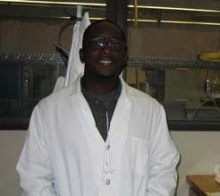
University:
Jackson State University
Major:
Chemistry
Mentor(s):
Stephan Kramer
Faculty Sponsor(s):
Carlos Levi
Faculty Sponsor's Department(s):
Materials
Project Title:
CMAS- A NEW CHALLENGE FOR THERMAL BARRIER COATINGS IN ADVANCED JET TURBINE ENGINES
Project Description:
The quest for the development of thermal barrier coatings in jet engines, which can withstand
extremely high temperatures, is on the rise. Thermal barrier coatings are ceramics that
enhance the performance and durability of turbine engines blades. Research in these TBCs is
very important for the booming aviation industry. New problems arise once the operating
temperatures of these coatings are increased. One of the challenges which this paper focuses
on is calcium-magnesium alumino silicate (CMAS). CMAS is a combination of sand, dust,
volcanic ash, and runway debris. At lower temperatures contaminants can cause erosive wear
to the TBC when impacting as solid debris. At higher temperature CMAS begins to melt when in
contact with TBC and infiltrates into the engine blades. The ultimate goal of this research is to
shed light on the properties of CMAS and ways to decrease aircraft engine damage. This paper
investigates the reaction mechanisms and chemical compositions for rare earth zirconates. The
Co-precipitation technique is used to produce the zirconates and to analyze the reaction with
CMAS as a function of varying ion size of the rare earth elements. Lanthanum, gadolinium and
yttrium zirconates were successfully prepared in the process to find the best solution to this
dilemma. The reaction effects and products are discussed further in this paper.
